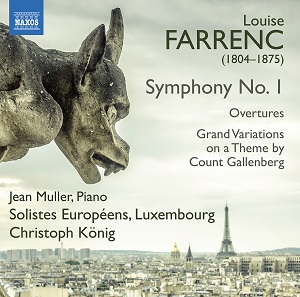 Louise Farrenc: Symphonie Nr. 1 op. 32 + Ouvertüren Nr. 1, op. 23 & Nr. 2, op. 24 + Gallenberg-Variationen op. 25 für Klavier & Orchester; Jean Muller, Klavier, Solistes Européens Luxembourg, Christoph König; 1 CD Naxos 8574094; Aufnahmen 2017/2018, Veröffentlichung 14/02/2020 (58'23) - Rezension von Remy Franck
Louise Farrenc: Symphonie Nr. 1 op. 32 + Ouvertüren Nr. 1, op. 23 & Nr. 2, op. 24 + Gallenberg-Variationen op. 25 für Klavier & Orchester; Jean Muller, Klavier, Solistes Européens Luxembourg, Christoph König; 1 CD Naxos 8574094; Aufnahmen 2017/2018, Veröffentlichung 14/02/2020 (58'23) - Rezension von Remy Franck
Die französische Komponistin Louise Farrenc (1804-1875) komponierte ihre Erste Symphonie op. 32 im Jahre 1841. Es sollte in dem an Symphonien eher armen Frankreich die erste von insgesamt drei sein. Uraufgeführt wurde sie in Brüssel am Februar 1845 unter der Leitung von François-Joseph Fétis.
Das halbstündige Werk hat vier Sätze, die allesamt sehr viril und kräftig klingen, vielleicht weil die Komponistin so erzürnt war, dass sie als Frau die Kompositionsklasse des Pariser Konservatoriums nicht besuchen durfte, da diese den Männern vorbehalten war.
1841 war das Jahr, in dem Mendelssohn an seiner Dritten, Schumann an seiner Ersten Symphonie arbeitete. Man könnte sagen, Farrencs Erste habe etwas von den beiden, aber auch Beethoven ist eine Vergleichsmöglichkeit. Eins ist sicher: Farrencs Symphonie ist eine sehr eigenständige Komposition, mit einem starken ersten Satz, Andante sostenuto – Allegro, dem ein sehr melodiöses Adagio cantabile folgt. Ein tänzerisches Menuett geht dem finalen Allegro Assai voraus, das Christoph König sehr flüssig dirigiert, so wie er das ganze Werk mit sehr viel Engagement angeht. König baut jeden Satz spannungsvoll und mit Gespür für die Farben der Musik auf und er weiß auch die dynamischen Werte so einzusetzen, dass ein Musikstück voller Leben entsteht, dynamisch, klangsinnlich und sehr expressiv.
Nicht weniger erfolgreich sind die Aufnahmen der beiden Ouvertüren Nr. 1 und 2, beide aus dem Jahr 1934. Die Solistes Européens Luxembourg spielen kraftvoll, farbig und mit viel Impetus, wobei, wie schon in der Symphonie, das kultivierte Holzbläserspiel auffällt.
Die Grandes Variations sur un thème du comte Gallenberg beschließen das Programm brillant. Das Ausgangsthema mag nicht das originellste sein, aber Louise Farrencs Variationen bringen Mehrwert.
Am Klavier spielt Jean Muller phantasie- und ausdrucksvoll. Blitzsaubere Streicher, prägnantes Blech und gewandte Holzbläser haben mit Königs rhythmisch geschärfter Darstellung überhaupt keine Schwierigkeiten und helfen das dramaturgische Konzept des Dirigenten optimal zu verwirklichen.
Eine angenehm räumliche und durchhörbare Tonaufnahme rundet den guten Eindruck ab, den diese CD hinterlässt.
French composer Louise Farrenc (1804-1875) composed her First Symphony op. 32 in 1841, the first of a total of three. It was first performed in Brussels on 23 February 1845 under François-Joseph Fétis. The half-hour work has four movements, all of which sound very virile and powerful, perhaps because the composer was so angry that as a woman she was not allowed to attend the composition class of the Paris Conservatory, as this was reserved for men.
1841 was the year in which Mendelssohn worked on his Third, Schumann on his First Symphony. One could say that Farrenc’s First has something of the two, but Beethoven is also a possibility of comparison. However it quickly becomes evident that Farrenc’s symphony is a very personal composition, with a strong first movement, Andante sostenuto-Allegro, followed by a very melodious Adagio cantabile. A dance-like minuetto precedes the final Allegro Assai. Christoph König’s account of the symphony is fluent and truly committed. Each movement is tenseful, richly detailed and coloured. With an excellent management of dynamic values the music is very lively and very expressive.
No less successful are the recordings of the two Overtures Nos. 1 and 2, both from 1934. The Solistes Européens Luxembourg play powerfully, with a broad palette of colours, whereby, as in the symphony, the cultivated woodwind playing is especially striking.
The brilliant Grandes Variations sur un thème du comte Gallenberg conclude the programme. The initial theme may not be the most original, but Louise Farrenc’s Variations bring added value.
Jean Muller’s playing is as imaginative as it is expressive. Superb strings, incisive brass and agile woodwinds have no difficulty at all with König’s rhythmically sharpened conducting and help to realize the conductor’s dramaturgical concept in an optimal way.
A pleasantly spatial sound recording rounds off the good impression of this CD.




















